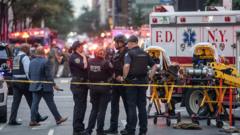In the late hours of Monday, a shocking shooting incident at 345 Park Avenue in Midtown Manhattan turned a bustling office space into a scene of terror, where panic and desperation spread among the workers. The skyscraper, housing several major corporations, was suddenly engulfed in gunfire, causing employees to flee for safety and seek shelter wherever they could.
As commuters prepared to head home on a hot July evening, Jessica Chen, a second-floor employee, recalled sending a heart-wrenching message to her parents, emphasizing the fear that gripped her: "I texted my parents, 'I love them,'" she stated, illustrating the harrowing experience witnessed by many in the building. The deadly event resulted in four fatalities, including 36-year-old police officer Didarul Islam, who was shot as he attempted to respond to an active shooting situation.
The assailant, 27-year-old Shane Tamura from Las Vegas, arrived at the New York skyscraper after an extensive cross-country drive. Armed with an AR-15-style rifle, he initiated the shooting just after 6:30 PM EST, targeting the lobby. Despite passing a rounded police officer, he swiftly killed Officer Islam upon noticing him, followed by indiscriminately firing at a woman and others nearby.
Tamura's shooter’s rampage caused chaos as terrified employees barricaded themselves and communicated the unfolding situation to colleagues quickly via emails and messages. Witnesses reported seeing employees piling furniture against doors in attempts to block the entrance, disclosing the panic felt within the skyscraper.
Meanwhile, as law enforcement surged to the location, Tamura’s attack took a critical turn when he mistakenly boarded the wrong elevator, thereby missing the NFL’s offices and instead ending up in a different part of the building, preventing potentially greater harm to his intended targets. Witnesses outside the building recounted the frantic scene as individuals fled, some visibly injured, seeking safety amidst the chaos.
As police worked diligently to piece together Tamura's recent journey leading to New York City, a disturbing three-page note recovered from him revealed his struggles with mental health issues, including references to CTE, a condition affecting many athletes due to repeated head trauma. In it, he also expressed resentment towards the NFL, fueling discussions on the broader implications of gun violence and mental health in America.
The response by law enforcement and building security, while swift under duress, highlighted significant gaps in emergency preparedness as details continue to emerge about the shooting and the events leading to it. This tragic incident not only demonstrates the ever-growing challenges of gun violence in the United States but raises urgent questions regarding how we address mental health crises and manage public safety effectively.
As commuters prepared to head home on a hot July evening, Jessica Chen, a second-floor employee, recalled sending a heart-wrenching message to her parents, emphasizing the fear that gripped her: "I texted my parents, 'I love them,'" she stated, illustrating the harrowing experience witnessed by many in the building. The deadly event resulted in four fatalities, including 36-year-old police officer Didarul Islam, who was shot as he attempted to respond to an active shooting situation.
The assailant, 27-year-old Shane Tamura from Las Vegas, arrived at the New York skyscraper after an extensive cross-country drive. Armed with an AR-15-style rifle, he initiated the shooting just after 6:30 PM EST, targeting the lobby. Despite passing a rounded police officer, he swiftly killed Officer Islam upon noticing him, followed by indiscriminately firing at a woman and others nearby.
Tamura's shooter’s rampage caused chaos as terrified employees barricaded themselves and communicated the unfolding situation to colleagues quickly via emails and messages. Witnesses reported seeing employees piling furniture against doors in attempts to block the entrance, disclosing the panic felt within the skyscraper.
Meanwhile, as law enforcement surged to the location, Tamura’s attack took a critical turn when he mistakenly boarded the wrong elevator, thereby missing the NFL’s offices and instead ending up in a different part of the building, preventing potentially greater harm to his intended targets. Witnesses outside the building recounted the frantic scene as individuals fled, some visibly injured, seeking safety amidst the chaos.
As police worked diligently to piece together Tamura's recent journey leading to New York City, a disturbing three-page note recovered from him revealed his struggles with mental health issues, including references to CTE, a condition affecting many athletes due to repeated head trauma. In it, he also expressed resentment towards the NFL, fueling discussions on the broader implications of gun violence and mental health in America.
The response by law enforcement and building security, while swift under duress, highlighted significant gaps in emergency preparedness as details continue to emerge about the shooting and the events leading to it. This tragic incident not only demonstrates the ever-growing challenges of gun violence in the United States but raises urgent questions regarding how we address mental health crises and manage public safety effectively.




















